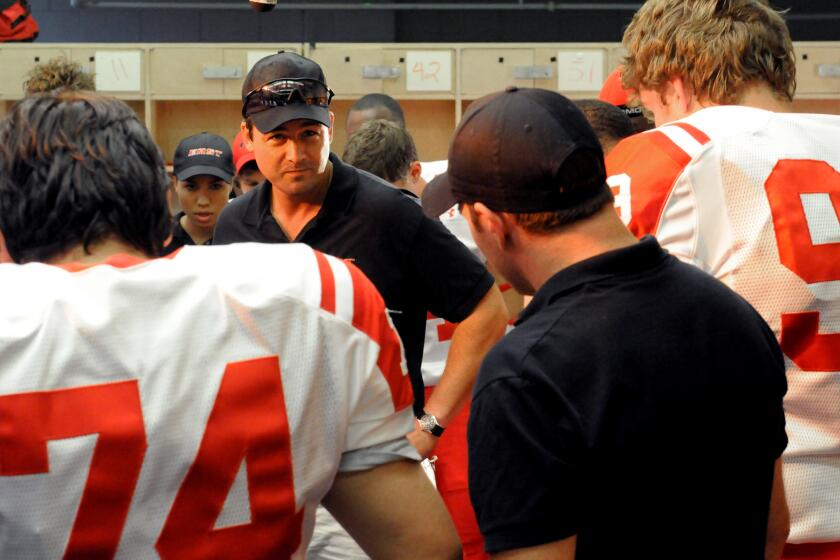The Eve of Uncertain V-Chip Era
Tim Collings admits feeling a bit like an expectant father on the eve of his creation, the V-chip, becoming available in the U.S., as new TV sets featuring the technology finally begin finding their way into American homes.
An assistant professor at Technical University of British Columbia in Surrey, B.C., Collings, a soft-spoken Canadian, didn’t set out to fuel controversy here when he came up with the idea for a device capable of blocking out what parents consider to be objectionable TV programs; in fact, he was merely seeking an engineering solution to what he viewed as an otherwise unmanageable problem: the explosion of content spilling out of television into society.
Collings decided to explore that area in the wake of an event that occurred a decade ago: the massacre of 14 engineering students in Montreal by a man whose apartment contained numerous violent videos.
“It’s almost remarkable the similarities with what happened at Columbine,” said Collings, 37, who had worked with engineering students and found himself particularly affected by the shootings. “It was very much what happened in the aftermath of all these types of incidents, a search for direction and for answers.”
Although sets equipped with the V-chip have already started hitting retail outlets, Thursday marks the Federal Communications Commission deadline for half of all new TVs to possess the technology. Television manufacturers have said they will also meet the goal established by the 1996 Telecommunications Act of having all new sets (13-inch or bigger) fitted with the blocking device by year’s end.
From its inception, Collings felt the V-chip--originally dubbed the Vyou Control (as in “view”) before Rep. Ed Markey (D-Mass.) seized on the issue--would address the increased availability of explicit content, due both to relaxed standards and new avenues of distribution, such as cable and satellite dishes. What he didn’t anticipate was the fierce 1st Amendment debate that ensued in the U.S.
“It was like walking into a bar and the fight was already well underway,” he said. “The goal was to allow individuals to make more intelligent choices. It didn’t seem to me like that would affect freedom of speech.”
Collings doesn’t see the V-chip as license for parents to cease monitoring what their children watch. Indeed, he’s a bit frustrated the focus has centered almost entirely on blocking shows parents deem objectionable, when the system will also allow parents to specify programs they deem appropriate for their kids and allow those shows to get through regardless of the rating.
“I felt if kids are really watching 25 hours [of television] a week, it’s worth the time and effort to educate yourself,” Collings said. “At no time did I think parents should abdicate their responsibility in this regard.”
Collings also conceded he’s been disappointed at times by opinion polls indicating minimal interest in, and knowledge about, the V-chip. “A lot of people will say, ‘I think I have a good handle on it in my home, it’s Joe next door who needs to do some work.’ I think everybody has to look at their own home first,” he said.
Nor did he envision the networks labeling their own programs, as they do now, or settling on a ratings system that would be carved in stone--a sign, he said, of how politicized the discussion became.
“I never thought it should end at ‘We’ve got one rating system, this one is going to work, let’s close the book on that,’ ” Collings said. “I thought it would be much more of a work in progress.”
Despite these misgivings, Collings remains excited to see how or even if people employ the V-chip after years of nay-saying, including contentions that resourceful kids will circumvent the system or techno-phobic parents will need their children’s help to master it.
Several organizations, including the Kaiser Family Foundation, Center for Media Education and National Cable Television Assn., have undertaken programs to educate people about the device; still, the lack of understanding that exists suggests this may not yet be a top-of-mind issue for most Americans, even with all the talk about Columbine, Colo.
“I feel like this is a really important junction,” Collings said. “Now we can finally have a look at this and whether people will really be using it.”
Although the V-chip will eventually be in every U.S. television sold, it remains unclear as to what the financial benefits will be to its creator. Collings’ patent was only granted last year, and licensing terms with manufacturers are still being hammered out.
Collings stressed his primary concern was never commercial gain and, sounding quite American, said whatever he ultimately makes from where the V-chips fall is “pretty much in the ballpark of the lawyers to figure out.”
The complete guide to home viewing
Get Screen Gab for everything about the TV shows and streaming movies everyone’s talking about.
You may occasionally receive promotional content from the Los Angeles Times.



